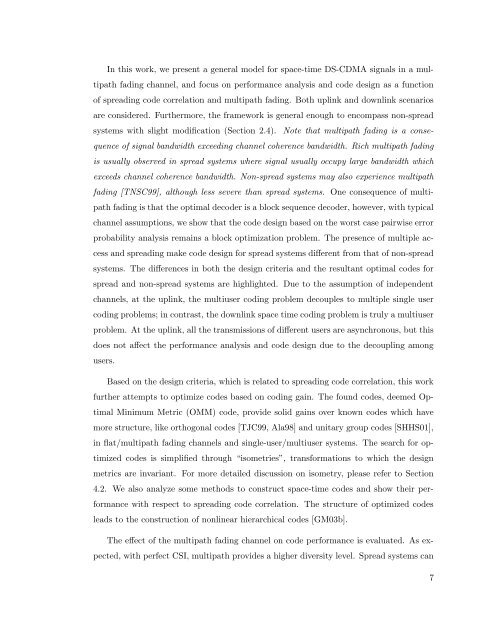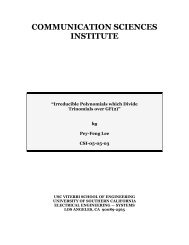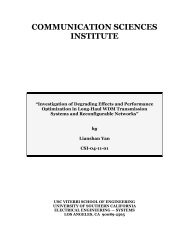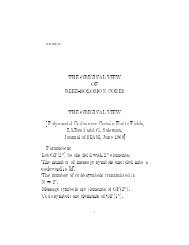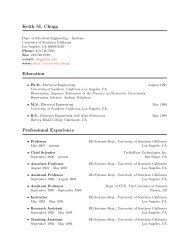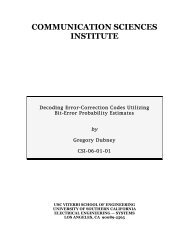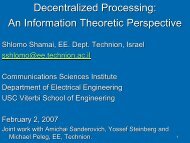Space-Time Block Codes for Wireless Systems - The ...
Space-Time Block Codes for Wireless Systems - The ...
Space-Time Block Codes for Wireless Systems - The ...
Create successful ePaper yourself
Turn your PDF publications into a flip-book with our unique Google optimized e-Paper software.
In this work, we present a general model <strong>for</strong> space-time DS-CDMA signals in a multipath<br />
fading channel, and focus on per<strong>for</strong>mance analysis and code design as a function<br />
of spreading code correlation and multipath fading. Both uplink and downlink scenarios<br />
are considered. Furthermore, the framework is general enough to encompass non-spread<br />
systems with slight modification (Section 2.4). Note that multipath fading is a consequence<br />
of signal bandwidth exceeding channel coherence bandwidth. Rich multipath fading<br />
is usually observed in spread systems where signal usually occupy large bandwidth which<br />
exceeds channel coherence bandwidth. Non-spread systems may also experience multipath<br />
fading [TNSC99], although less severe than spread systems. One consequence of multipath<br />
fading is that the optimal decoder is a block sequence decoder, however, with typical<br />
channel assumptions, we show that the code design based on the worst case pairwise error<br />
probability analysis remains a block optimization problem. <strong>The</strong> presence of multiple access<br />
and spreading make code design <strong>for</strong> spread systems different from that of non-spread<br />
systems. <strong>The</strong> differences in both the design criteria and the resultant optimal codes <strong>for</strong><br />
spread and non-spread systems are highlighted. Due to the assumption of independent<br />
channels, at the uplink, the multiuser coding problem decouples to multiple single user<br />
coding problems; in contrast, the downlink space time coding problem is truly a multiuser<br />
problem. At the uplink, all the transmissions of different users are asynchronous, but this<br />
does not affect the per<strong>for</strong>mance analysis and code design due to the decoupling among<br />
users.<br />
Based on the design criteria, which is related to spreading code correlation, this work<br />
further attempts to optimize codes based on coding gain. <strong>The</strong> found codes, deemed Optimal<br />
Minimum Metric (OMM) code, provide solid gains over known codes which have<br />
more structure, like orthogonal codes [TJC99, Ala98] and unitary group codes [SHHS01],<br />
in flat/multipath fading channels and single-user/multiuser systems. <strong>The</strong> search <strong>for</strong> optimized<br />
codes is simplified through “isometries”, trans<strong>for</strong>mations to which the design<br />
metrics are invariant. For more detailed discussion on isometry, please refer to Section<br />
4.2. We also analyze some methods to construct space-time codes and show their per<strong>for</strong>mance<br />
with respect to spreading code correlation. <strong>The</strong> structure of optimized codes<br />
leads to the construction of nonlinear hierarchical codes [GM03b].<br />
<strong>The</strong> effect of the multipath fading channel on code per<strong>for</strong>mance is evaluated. As expected,<br />
with perfect CSI, multipath provides a higher diversity level. Spread systems can<br />
7


